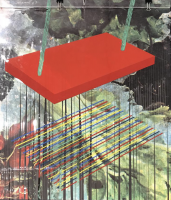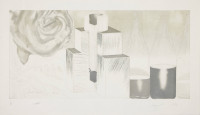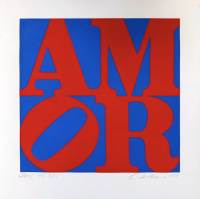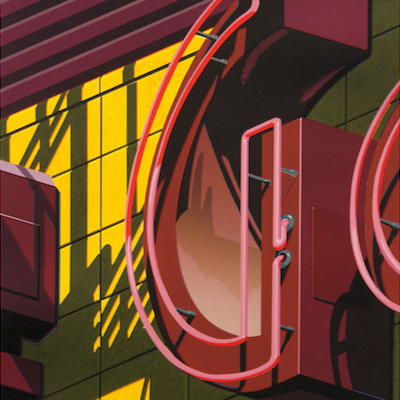
Details
Artist
Styles
Original lithograph and screenprint - Signed and numbered by the artist in pencil // Flamingo Capsule by James Rosenquist, created in 1973, is a vibrant and multifaceted screenprint that showcases Rosenquist's signature pop art style, blending surreal and familiar elements into a dynamic composition. This large-scale print features an array of fragmented images: a section of an American flag, metallic textures, abstract shapes, and vivid color gradients that range from pink to orange. These disparate elements are seamlessly integrated, creating a sense of movement and energy reminiscent of a capsule or compressed space. Rosenquist's use of bright colors and high-contrast visuals echoes the influence of commercial art and advertising, while also inviting deeper interpretations about American culture and consumerism. The juxtaposition of objects and textures gives the piece an almost dreamlike, futuristic quality, making Flamingo Capsule both visually striking and thought-provoking.
Flamingo Capsule, 1973
form
Medium
Size
91 x 198 cm
- Inches
- Centimeters
Edition
Price
- USD
- EUR
- GBP
Details
Artist
Styles
Original lithograph and screenprint - Signed and numbered by the artist in pencil // Flamingo Capsule by James Rosenquist, created in 1973, is a vibrant and multifaceted screenprint that showcases Rosenquist's signature pop art style, blending surreal and familiar elements into a dynamic composition. This large-scale print features an array of fragmented images: a section of an American flag, metallic textures, abstract shapes, and vivid color gradients that range from pink to orange. These disparate elements are seamlessly integrated, creating a sense of movement and energy reminiscent of a capsule or compressed space. Rosenquist's use of bright colors and high-contrast visuals echoes the influence of commercial art and advertising, while also inviting deeper interpretations about American culture and consumerism. The juxtaposition of objects and textures gives the piece an almost dreamlike, futuristic quality, making Flamingo Capsule both visually striking and thought-provoking.
- Recently Added
- Price (low-high )
- Price (high-low )
- Year (low-high )
- Year (high-low )
James Rosenquist
Whipped Butter For Eugene, 1965
Limited Edition Print
Screen-print
Inquire For Price
James Rosenquist
Where The Water Goes (from The Welcome To The Water Planet), 1989
Limited Edition Print
Collage
Inquire For Price
James Rosenquist
Federal Spending (second State), 1978
Limited Edition Print
Etching And Aquatint
Inquire For Price
James Rosenquist
A Pale Angels Halo (Yellow), 1973
Limited Edition Print
Lithograph
Inquire For Price
James Rosenquist
Federal Spending, 1978
Limited Edition Print
Etching And Aquatint
Inquire For Price
James Rosenquist
Just Desert Israel 2nd State, 1979
Limited Edition Print
Intaglio
Inquire For Price
James Rosenquist
Window Washer Glass House (black And White), 1978
Limited Edition Print
Mixed Media
Inquire For Price
James Rosenquist
The Flame Still Dances On Leos Book, 1997
Limited Edition Print
Lithograph
Inquire For Price
James Rosenquist
The Kabuki Blushes (from Secrets In Carnations), 1986
Limited Edition Print
Mixed Media
USD 8,950
James Rosenquist
The Book Disappears For The Fast Student 2nd State, 1978
Limited Edition Print
Etching And Aquatint
USD 1,100
James Rosenquist
Spring Cheer, 1st. State , 1978
Limited Edition Print
Etching And Aquatint
USD 4,250
James Rosenquist
Sunglass Lens - Landing Net - Triangle, 1974
Limited Edition Print
Etching
Inquire For Price
James Rosenquist
The World Art Festival, 1982
Limited Edition Print
Lithograph
Currently Not Available
What is Hyper-realism?
Hyperrealism is a genre of sculpture and painting that closely resembles high-resolution photographs. It is an evolution of Photorealism and is often applied to an independent art style or movement that became prominent in Europe and the United States in the early 2000s. Hyperrealist artists focus on extreme detail and precision, creating works that are often indistinguishable from real-life images.



























































